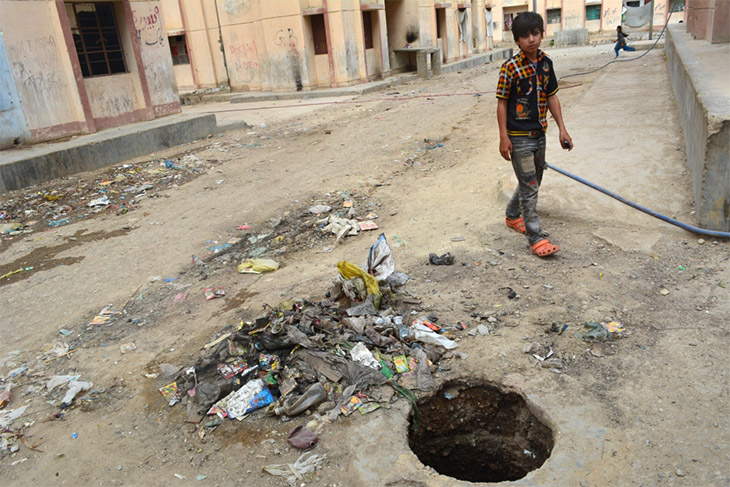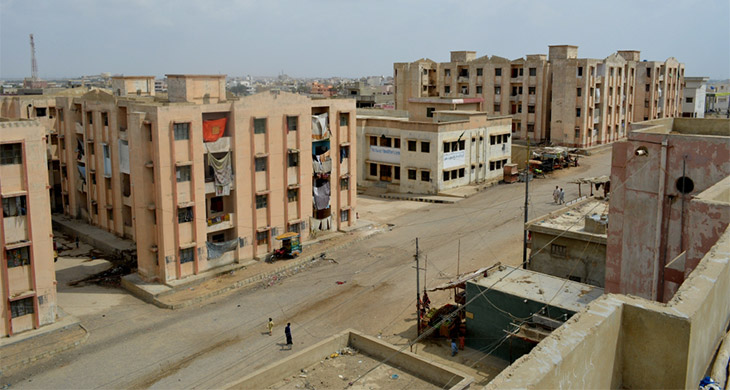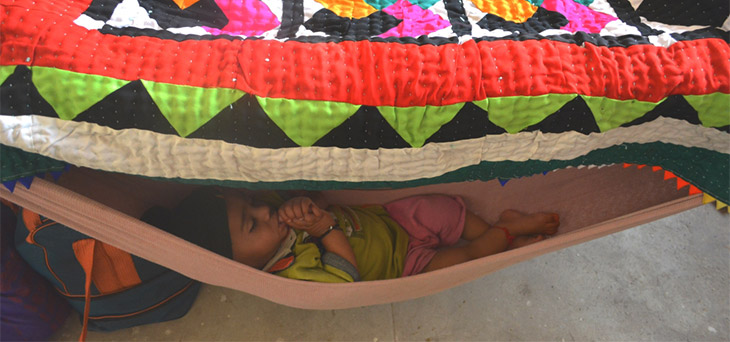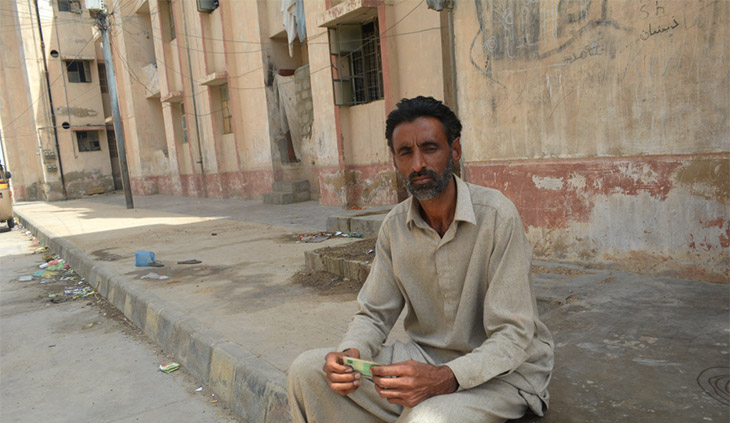Internally displaced persons still struggling five years after Pakistan floods
In this regular blog, researched and commissioned by CRJ’s Pakistan correspondent Luavut Zahid, freelance environmental writer Amar Guriro describes the continued plight of former agricultural workers displaced by Pakistan’s ‘Super Flood’ of 2010
It was late evening when suddenly the vast compound in Pakistan’s ‘City of Lights’ plunged into darkness. Officials from the power company had come to disconnect illegal connections in the slum.
There are around 500 slum settlements in Pakistan’s commercial hub of Karachi, scattered on the empty plots across the city in areas where poor people have constructed makeshift huts on government land.

A boy passes an open pothole in Karachi’s Labour Square slum; residents are suffering from the absence of a proper sanitation system to the building, which houses 1,000 flats (Photo by Amar Guriro)
But this is unique. Labour Square is a multi-storey building divided into blocks and comprises 1,000 two bedroom, one lounge units. Landless farmers from the northern Sindh districts, around 500 to 700km from Karachi, who were uprooted by the 2010 floods, occupy these apartments.
Just a kilometre away from country’s busiest road – the Super Highway, which carries cargo and public transport from the port city to up country, – the huge Labour Square building was constructed for industrial labourers by the government.

The Labour Square building, which is divided into different blocks with 1,000 small flats, is occupied by the 2010 flood victims. The government has gone to court to evacuate the residents from the building (Photo by Amar Guriro)
However, as will be explained below, the government subsequently declared the occupation of the building by former agricultural workers displaced by floods, as being illegal and has designated the building as a slum. This means that state departments have stopped providing basic facilities, including drinking water, sanitation, electricity and natural gas connections.
During the devastating floods of 2010 – now known as the Pakistan Super Flood – the country’s lifeline, the River Indus, swamped one-fifth of its total basin area.
The country’s worst flooding in recent history, believed to be a result of climate change, not only damaged crops, infrastructure and human settlements, but also uprooted millions of people from their home villages. According to official data, 78 out of the country’s 121 districts were badly affected by the floods, which inundated an area of more than 100,000 square kilometres.
The flood badly affected transport and communication networks, water and irrigation channels, power and energy plants and grids.

Sultan Ahmed sitting in his small house in Karachi’s Labour Square. He says that all the flood victims are agricultural labourers, but the government is not ready to hand these houses to them, despite them being constructed to house workers (Photo: Amar Guriro)
When floodwaters reached the northern Sindh districts along the River Indus, a large number of people started migrating from their homes, mostly on foot, as transportation provision was sparse to say the least. Some of these flood victims reached Karachi. Of course, they were lucky to have survived. But now they struggle to live.
Take Habiba Khatoon Khosa, who travelled more than 450 kilometres from her native village in Jacobabad district of Sindh to reach the provincial capital Karachi. But even when she reached the country’s commercial hub, life was hard.
“When we came here first, there wasn’t any place to go and for three nights we lived on the road under the open sky,” she said.
Later on, people displaced by the floods found out about Labour Square and moved in. “Initially we were not allowed to enter, but with help of some political parties and Sindhi nationalists, we managed to enter the building,” said Khosa. She added that initially government authorities and several non-governmental organisations (NGOs) came to assist, but gradually, over time, this support dwindled and faded away.
So, most of the slum dwellers in this building are poverty-stricken former farm workers who previously lived along the banks of the River Indus, forced from their homes by flooding and who ended up in this slum in the outskirts of Karachi.
Now, five years on, they cannot return to their homes. While living in the slum, these peasants cannot continue their ancestral farming jobs and have had to find other ways of earning a living. Ghulam Nabi Shar, a traditional farmer in his village Sarang Shar, in northern Sindh’s Shikarpur district, is now working as mason.

Muhammad Akram, one of the 2010 flood victims living in Karachi’s Labour Square, shows his national identity card. He belongs to a remote village of Jacobabad district in northern Sindh, some 450km from Karachi. He misses village life, but says he cannot afford to move home (Photo by Amar Guriro)
And after five years, they still do not have official electricity connections, so they have had to hook wires to nearby poles to obtain power. Most of the residents say they would like to obtain official power supplies, but the power company has refused to connect them, saying that they have occupied the compound illegally.
Many have expressed surprise that the Sindh provincial government constructed the compound for labourers but, when a disaster forced agricultural labourers to come and live in it, the government termed their occupation illegal and has applied to the courts for their eviction. “Often police comes to force us to leave the place,” said another resident of Labour Square, Abdul Aziz Khoso.
The slums lack basic facilities, including proper sanitation, drinking water, natural gas or electricity connections, nor does it have a school or basic healthcare facilities. Women have walk for miles to fetch water from a hydrant. In absence of the natural gas, they have to go to nearby hills to find wood or dry cow dung as domestic fuel to cook with.

Infant Ali Hassan sleeps in a traditional hammock, which is set by tying long cloth with Charpai, in a house in Labour Square, in the outskirts of Pakistan’s port city of Karachi. Children suffer diarrhoea and other abdominal diseases in the slum, owing to unhygienic conditions (Photo: Amar Guriro)
However, officials from the Provincial Disaster Management Authority (PDMA) Sindh, the official department that carries out rescue, relief and rehabilitation after disasters, have explained that Labour Square and other places were officially declared as temporary relief camps during floods 2010. They are now no longer designated as relief camps, they say, as flood victims are being encouraged to return home to their villages.
“As these camps are not official, we can’t provide any facilities for them; the residents must return to their native places, for which government has given them a huge amount money, so that they can restart their lives at their old places,” said Director General, PDMA, Sindh, Syed Salman Shah.
The Sindh government initiated the Watan Card (a special type of ATM card to help flood victims). In the first phase of this scheme, the government gave Rs19,000 (around $190) to every registered family so that they could purchase food. A further instalment of Rs 80,000 (approximately $800) was planned so that flood-affected people could rebuild homes and their lives.
“During the floods we lost everything, including our houses, standing crops and the land was damaged and cattle died, but the government wanted us to manage all these things with a mere amount of Rs 80,000, which is impossible,” said Sultan, noting: “And we didn’t even receive that second instalment.”
According to other residents, the cost of transportation back to their villages was greater than the sum offered by the government to rebuild their houses.
Back in her village, Habiba Khatoon Khosa was once an embroidery designer, earning a good living making traditional Sindhi Ralli (quilts with colourful patch work) and shirts. “Here in Karachi city, I have no idea where to sell these quilts,” she said.

Habiba Khatoon Khosa, a resident of Karachi’s Labour Square, shows her traditional embroidery. Before 2010 when the floods forced her and her family to leave their native village in northern Sindh, she used to stitch and earn good money, but in Karachi she is not aware where to sell or market these clothes (Photo: Amar Guriro)
She adds that in their village they had a huge Otaq (a traditional guest house), where they received a large number of guests every day. But it is no longer possible to keep these traditions alive.
“The flood has changed everything, including century-old traditions. Look, we have to pay for drinking water here. In our village we did not even sell milk, we would give it away for free if someone was in need,” said Muhammad Akram.
Since the government has declared their occupation of the building illegal, different civic agencies, including water supply and sanitation departments, will not operate in the compound. Heaps of garbage lie everywhere and choked gutters are attracting flies and mosquitoes. “Due to unhygienic conditions, malaria, diarrhoea and even hepatitis is common in among the residents,” said Kaptan Buriro, who himself is has hepatitis-D.

Kaptan Buriro, resident of Karachi’s Labour Square slum, has hepatitis-D. Most of the residents are suffering from various diseases caused by the unhygienic conditions in which they live and from contaminated water (Photo by Amar Guriro)
These internally displaced people in Karachi are just one example of the continued legacy of 2010’s devastating flooding. However, there is large number of the victims who are living in different areas and facing similar conditions. Many accuse the authorities of not even being aware of their presence.
Amar Guriro is Karachi based freelance environmental journalist. He tweets @AmarGuriro
Luavut Zahid, 14/05/2015